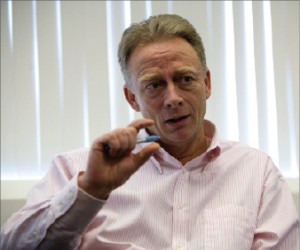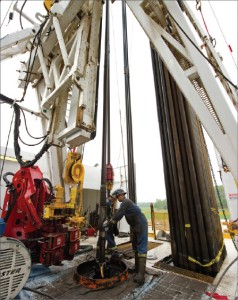Ensuring discipline in process safety: Make it visible, measurable
Critical issues in drilling & completions with Peter Sharpe, executive vice president for wells, Shell International E&P
By Diane Langley, editorial coordinator

How is Shell poised to meet the energy challenges of today and tomorrow?
Over the last few years, Shell has been developing its new wave of long-life legacy projects. We’ve invested more capital than our supermajor peers and have 11 billion bbl under construction due to come on-stream through 2012 and a further 8 billion bbl oil equivalent in the design phase.
In what areas do you expect to see significant capital investment?
We are fully committed to deepwater going forward and believe that we have the experience and ability to safely grow our business in this area. What is different looking to the future is the percentage increase of Shell’s capital that will be invested in the Wells part of the business, which could double through the next decade.
What are the key challenges for Shell and what is being done to offset them?
Our first priority is to be a high-reliability organization in both personal safety and in process safety. We need to be reliably at zero in terms of major process safety events, and we need to continue our progress toward zero in the area of personal safety.
We have made progress over the last few years with record-lows in terms of recordable case frequency. Simple rules around personal safety, like our 12 lifesaving rules and driving compliance to those rules, have been a major component of our progress.
In Wells, we have also changed leadership focus to areas of major risk. Our focus in the last few years has been on learning from high-potential near-misses, the incidents that have the potential for fatalities. As a result, we have reduced the frequency of high-potential events. For example, we have significantly reduced the frequency of dropped objects, which represented more than 50% of our potential fatalities.
Process safety has been a major focus in Shell for many years. In Wells, it became clear that we needed full transparency to drive compliance, and so we introduced an electronic global Well Integrity Management System in 2008, called eWIMS, in which our 15,000-plus wells are actively managed. I can sit at my desk and see in real time whether corrective or preventive maintenance has been done and be confident that all our wells globally are in full compliance with our well integrity standard.
We have taken this approach a step further and are implementing a similar system for the construction phase of our wells called electronic Well Construction Assurance Tool (eWCAT). This will allow us to measure compliance against our well control standards around competency of people, certification of equipment, quality of barriers, design derogation and so forth. Both systems provide key metrics to measure discipline, compliance and make risk and management of change visible.
You can see our commitment to what we call Goal Zero reflected back to us through the Shell people survey covering 100,000 Shell staff each year. I truly believe safety is a core value in Shell. The HSE Control Framework and our Golden Rules support this by expecting three overarching behaviors: complying with the rules, intervening when it feels wrong, and respecting people, the environment and our neighbors.
Are there other key challenges?

We operate more rigs in more locations than any other IOC, so developing our people and getting the culture right are our main focus. We are always looking for ways to grow the competence of our staff. Shell’s well engineers undergo a rigorous three-year minimum training program, which includes profound course work, mandatory exams and on-the-job training in the field and in the office. The Round 1 and Round 2 examinations lead to an accreditation for chartered engineer and credits for Master of Science qualification in well engineering.
What’s particularly differentiating about it, from my perspective, is the fact that historically only 80% of graduates pass the exams. We believe our program is a gold standard in the industry. We’ve been expanding it to staff working in interventions and have recently introduced a new advanced expanded well control training course.
How do people contribute to lowering process safety incidents?
Developing the competence of our people, as well as constant improvement of our equipment, standards and metrics, are important, as is reporting and learning from all near-misses and incidents. However, the key is getting the culture right.
People must believe that the low-frequency, high-consequence incidents can happen to them and be prepared to take action; we cannot go about our daily operations hoping for the best. Everybody has to fully understand the risks and be prepared and empowered to stop the operation if they have concerns.
Getting the job done cannot be the priority; we need to have a preoccupation with failure, be focused on abnormalities, fascinated by what we don’t know and be a humble and efficient learning organization.
How does equipment contribute to lowering process safety incidents?
On the equipment side, Shell applies a multilayered well control system designed to minimize risks, so if any one system or device fails, it should not lead to a loss of containment. We want full transparency on the quality of our barriers at all times and, to that end, are introducing new technology such as non-intrusive annular pressure monitoring with real-time seabed telemetry systems on our subsea wells to monitor the quality of the cement barrier.
We want to make visible at all stages of well construction that equipment meets our requirements and regulatory standards and that barrier testing has been undertaken as per design load cases.
Did the recently lifted moratorium have an effect on the number of competent people within our industry? Did we lose personnel momentum?
During the recent moratorium, we reached an agreement with our drilling contractors that all rig workers would be retained, so we didn’t have leakage of critical skills. We are doing everything we can to recruit and retain people. We’ve been working hard on the demographic challenge.
Do you believe the Macondo incident will change the way in which Shell conducts operations in the Gulf of Mexico?
Post-Macondo, we did a number of things. We’ve looked to see whether there were any gaps in our existing standards and where can we improve. We believe in continuous improvement. For example, we have started to look at how well our safety cases have been operationalized. We have also formed with our partners the Marine Well Containment Company, which is committed to design, build and maintain readiness of a subsea well containment system.
What contribution is technology making to ensure that a Macondo incident does not occur again?

We are working on a wide range of technologies, from containment technology to BOP functionality and control systems. I believe that a higher level of instrumentation and artificial intelligence for process safety control will make a difference. Automation obviates the complete reliance on an individual to take action to close the well. While we already have 24/7 monitoring, we need to start working on a setup where processes would actually be shut down without human interventions.
As much as we do to prevent an emergency situation, we also continue our work on tertiary well control tools and techniques to shut off deepwater wells safely and quickly. Shell owns well-capping systems, and our engineers are working on enhancements to make the equipment suitable for a broad range of well control events in order to cover specific future requirements of all global operating areas.
As mentioned before, we have also teamed up with ExxonMobil, Chevron and ConocoPhillips to build equipment to improve the industry’s capability to contain a deepwater well control incident in the Gulf of Mexico.
We also believe technologies such as deepwater subsea rigless intervention can make the industry safer and increase ultimate recovery from deepwater reservoirs. In 2009, I think we surprised the industry with a riserless open-water wireline intervention in 3,000 feet of water. The ability to do interventions safely with two independent barriers in place, and with small intervention vessels at lower cost, is a significant step forward.
Looking at onshore gas – the high-density drilling business – we’ve been working on the challenge of being much more efficient. Shell has done a lot of work on rig automation, smart algorithms and ROP optimization without need for expert personnel at the well site.
What are the hard truths about drilling and completion on land and offshore and what choices are being made to maintain a strong exploration future?
The real hard truth is that a public confidence threshold has been crossed post-Macondo. This will become a reference point not just for deepwater. For us to retain our license to operate and meet societal expectations, we need to be fully transparent in everything we do in order to rebuild the confidence that has been lost.
